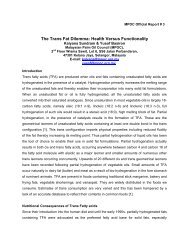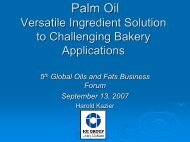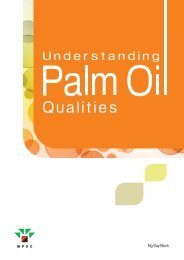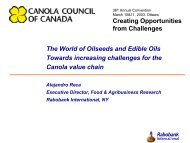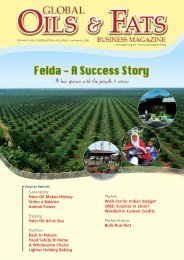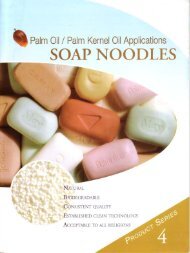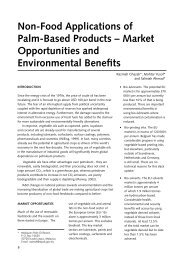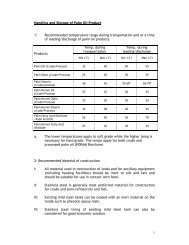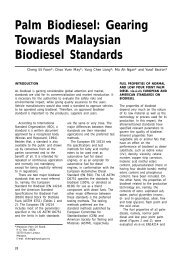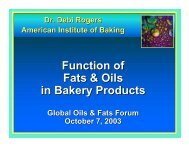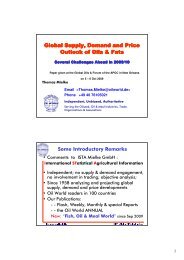Soybean Pipeline - American Palm Oil Council
Soybean Pipeline - American Palm Oil Council
Soybean Pipeline - American Palm Oil Council
You also want an ePaper? Increase the reach of your titles
YUMPU automatically turns print PDFs into web optimized ePapers that Google loves.
<strong>Soybean</strong> <strong>Pipeline</strong>:<br />
Moving Beyond A Commodity<br />
Mark Winkle, Ph.D.<br />
Senior Director of Domestic Programs,<br />
United <strong>Soybean</strong> Board
Outline<br />
• QUALISOY<br />
• Status of the current U.S. soybean oil market<br />
• Marketplace opportunities and challenges<br />
• <strong>Pipeline</strong> of new traits – meeting the needs of<br />
industry
QUALISOY Industry Coalition
QUALISOY Board<br />
Involves all members of the soybean value chain
Why QUALISOY?<br />
QUALISOY as a persuasive business platform:<br />
• Broad-based U.S. industry coalition<br />
• Help initiate market pull-through<br />
• Expedite the identification of key traits<br />
• Accelerate trait commercialization<br />
• Enable sharing of trait discoveries to promote<br />
widespread acceptance<br />
• Promote market acceptance of traits
Current Status of the U.S.<br />
<strong>Soybean</strong> <strong>Oil</strong> Market
North <strong>American</strong> <strong>Oil</strong>seeds<br />
2008 Acreage <strong>Oil</strong> Production (billion lbs.)<br />
USDA , StatsCanada and Galloway & Associates
Soy <strong>Oil</strong> Use in the U.S.<br />
USE PERCENT BILLIONS OF<br />
POUNDS<br />
Salad/Cooking <strong>Oil</strong> 66 10.3<br />
Baking/Frying 28 4.4<br />
Margarines/Spreads 5 .8<br />
Other Edible 1 .2<br />
TOTAL 100 15.7<br />
Source: Census Bureau, USDA 2008
U.S. Edible <strong>Oil</strong> Usage<br />
(ooo)<br />
(ooo)<br />
Left Axis<br />
Right Axis<br />
Source: Census Bureau, USDA 2008
The <strong>Soybean</strong> <strong>Oil</strong> Value Pie<br />
(000) lbs. oil<br />
Galloway & Associates, 2009
Marketplace Opportunities<br />
and Challenges
Food Industry Viewpoint<br />
• <strong>Soybean</strong> oil a food industry favorite<br />
– Favorable price structure<br />
– Wide range of functionality<br />
– Familiar, predictable flavor characteristics<br />
• Soy does not camouflage or overpower food flavors<br />
– Abundant availability<br />
• Large number of potential suppliers<br />
– Secure supply from crop year to crop year<br />
– Short pipeline from production to usage
Macroeconomic Analysis<br />
U.S. Edible<br />
Fats & <strong>Oil</strong>s<br />
Consumption<br />
(million lbs.)<br />
• Vegetable oil usage is down<br />
--Recession<br />
--Health/dietary concerns<br />
Source: US Census Bureau & USDA
Food Industry Trans Solutions<br />
• Naturally Stable <strong>Oil</strong>s<br />
• Blends<br />
– Mix 5-10% hard stock (no trans fats), 90-95% unhydrogenated<br />
oils<br />
– Interesterify to customize desirable melt points<br />
• Modification of Processing Techniques<br />
– i.e. modifying hydrogenation process<br />
• Catalyst, time, temperature, pressure<br />
• Trait-Enhanced <strong>Oil</strong>s<br />
– High-oleic canola, low-linolenic soy<br />
• Gels, Emulsifiers and Other Texture-Building Agents
Trans Fat Replacement <strong>Oil</strong>s<br />
Trans-Fat Replacement <strong>Oil</strong>s<br />
Low-Linolenic Soy<br />
High-Oleic Canola<br />
<strong>Palm</strong><br />
Other Stable <strong>Oil</strong>s<br />
TOTAL Estimated Supply<br />
Lbs. of <strong>Oil</strong><br />
1 billion lbs.<br />
600 million lbs.<br />
1 billion lbs.<br />
1 billion lbs.<br />
3.6 billion lbs.<br />
2008 estimates from fats and oils industry
New Traits to Meet<br />
Marketplace Needs
Current Solution for Food<br />
Industry<br />
Low-Linolenic Acid <strong>Soybean</strong> <strong>Oil</strong><br />
• Maximum 3% linolenic vs. 7% in traditional<br />
soybean oil<br />
• Provided a soy-based solution to stability<br />
without trans-fats<br />
– One billion lbs. are being utilized annually<br />
– Adequate oxidative stability in a broad range of<br />
applications<br />
– Appealing end product flavor<br />
– Excellent shelf life characteristics
Next Innovations<br />
• High-oleic soy ~ 2010/11<br />
– 78-85% oleic<br />
• High-stearate soy ~2012<br />
– 18-25% stearic acid content<br />
• High omega-3 soy ~2012<br />
– 21–24% omega-3 content – 10x current content<br />
• Mid-oleic/low-saturate soy ~ 2012/13<br />
– 60%+ oleic/7% saturates
<strong>Soybean</strong> Industry has its Eye<br />
on the Future
<strong>Soybean</strong> Industry Portfolio<br />
Omega‐3<br />
(Monsanto;<br />
Bt/RR2Y<br />
Steandonic Acid)<br />
(Monsanto)<br />
RR2Y<br />
(Monsanto)<br />
High<br />
Stearate<br />
(Monsanto;<br />
DuPont)<br />
High Beta‐<br />
Conglycinin<br />
(Monsanto;<br />
DuPont)<br />
Low‐<br />
Phytate<br />
(DuPont)<br />
Low‐Sat<br />
(Monsanto)<br />
Dicamba Tolerant<br />
(Monsanto)<br />
Feed: High Protein<br />
<strong>Soybean</strong><br />
(Monsanto; DuPont)<br />
Omega‐3<br />
(EPA/DHA)<br />
DuPont<br />
Rust<br />
(Monsanto;<br />
Pioneer<br />
Yield<br />
(Monsanto;<br />
Pioneer)<br />
Agronomic<br />
Quality/Food<br />
Nematode<br />
Resistance<br />
(Syngenta)<br />
Antibody ‐<br />
containing<br />
(against E. coli<br />
0157:H)<br />
2010 2012<br />
2020<br />
Liberty<br />
Link<br />
(Bayer)<br />
High‐Oleic<br />
(DuPont)<br />
Imidazolinone<br />
tolerant<br />
(BASF/Embrapa Brazil)<br />
GAT/Glyphosate‐<br />
ALS soybean<br />
(DuPont/Pioneer)<br />
Industry Inputs May 2009<br />
Low‐linolenic<br />
(Syngenta)<br />
Mid‐Oleic /<br />
Low‐Sat<br />
(Monsanto)<br />
Glyphosate &<br />
isoxaflutole<br />
tol.<br />
(Bayer)*<br />
Modified 7S<br />
Protein FF<br />
(Dupont)<br />
Processing: High<br />
<strong>Oil</strong> Soy<br />
(Monsanto)<br />
High‐Oleic,<br />
Stearate<br />
(DuPont)<br />
HPPD<br />
Toleran<br />
t<br />
(Syngenta<br />
)<br />
Herbicide tol.: 2,4‐D<br />
and “fop”/ aryloxyphenoxy<br />
propionate herbicides (Dow)<br />
SCN<br />
Monsanto; Pioneer<br />
Disease<br />
(Monsanto;<br />
Pioneer)<br />
Disease<br />
(Syngenta)
Solutions Available in Short-Term<br />
Low-Linolenic Soy<br />
Mid-Oleic/Low-Sat Soy<br />
High-Oleic Soy<br />
High<br />
Omega-3<br />
Soy<br />
High-<br />
Stearic<br />
Soy
<strong>Soybean</strong>’s Future Looks Bright<br />
• Many soybean varieties with beneficial traits in the<br />
pipeline<br />
– Trans fat elimination<br />
– Improved functionality<br />
– Healthfulness<br />
• Future crop plantings anticipated to be good<br />
• QUALISOY positioned to help pave the way for a<br />
healthy soybean industry



